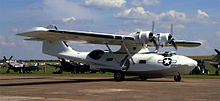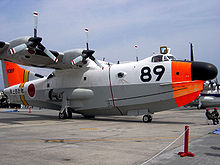Flying boat


A flying boat , sometimes also called a flying ship , is an aircraft whose hull is buoyant and which can take off and land on the water. This distinguishes it from other seaplanes with mostly rigidly mounted landing gear (floating mechanism). Flying boats that also have a landing gear are also called amphibious aircraft .
In Germany, the operation of flying boats is only possible to a limited extent due to the mandatory airfield . There are few areas for seaplanes and flying boats .
Construction and construction
Compared to a float plane, a flying boat has the advantage of lower weight, constructional effort and air resistance, since there are no voluminous swimmers in addition to the fuselage. Small seaplanes, however, are preferably designed as float planes, because the engine and cockpit are less exposed to the spray water during take-off and landing.
In the early years of commercial air travel, after the First World War, flying boats were used because they could also fly to places without an airfield. Even long distances, which could not be flown non-stop with the aircraft of the time, could be covered step by step with a flying boat without having to have an airfield at each stopover. Flying boats have only rarely been used in commercial scheduled services since the 1940s.
In the 1930s, in addition to a pilot's license, a captain's license for seafaring to drive the flying boats was common at German Lufthansa .
Flying boats offer advantages:
- Long available take-off and landing routes on waters.
- Lots of space to take off and land at the same time.
- Well-developed seaport infrastructure .
- In addition, the ground effect allows the flying boat - flying at a low height above the surface - a greater range (there are special ground effect vehicles , also called "Ekranoplan", which make use of this effect).
In practice, however, there are various problems:
- Lifting off the surface of the water is difficult. The first flying boat hulls were based on the existing boat types flat boat and keel boat. It was only later discovered that the aircraft's float needed a “ step ” in order to overcome the suction effect of the water.
- The stern tail of the flying boats was often set too low. On the Do X , for example, this led to the tail unit being torn down. Later designs therefore usually have a significantly higher tail unit.
- Even a slight wind can make a flat water surface rough, on which it is difficult to splash down and becomes all the more difficult with more wind. The water hammer of the watering flying boat is also dangerous for the engines. The swell on the high seas made ditching almost impossible.
- Even in shallow seas, the waterfall poses challenges for the pilots: For example, the pilot can only poorly assess the altitude of the flying boat over the water, as features such as trees, buildings or the like are usually missing. Floating relatively steeply and catching the aircraft shortly before landing / landing, as is possible with land planes, is dangerous with a flying boat (water hammer).
- The necessary shape of the float is aerodynamically not particularly favorable and is disadvantageous for the flight characteristics. With increasing flight speeds, this disadvantage compared to land aircraft becomes greater and greater.
Use in passenger traffic
With the onset of passenger traffic, the question arose of how the future large passenger aircraft should take off and land. Since lift aids , landing and fowler flaps had not yet been developed at the time , the designers calculated immensely long take-off and landing distances for these aircraft; Land routes that at the time did not seem feasible on land. So it made sense to resort to the water. Sikorsky and the PanAm did it very successfully on the Pacific routes ( San Francisco - Honolulu - Wake - Manila - Hong Kong ); the Germans, French and Italians on the South America routes. The British (starting with Imperial Airways ) used land planes as well as flying boats like the Short Empire to open up the Empire in terms of air traffic.
PanAm had three Sikorsky S-40s (first flight of the S-40 in the service of PanAm on November 19, 1931 from Miami to Barranquilla (Colombia)). The S-40 was used on scheduled flights to Mexico, Cuba and the Bahamas until it was replaced by its successor - the Sikorsky S-42 . The S-42 ushered in a new era of long-haul flight together with the other Clipper flying boats Boeing 314 and Martin M-130 .
Development history
One of the first flying boats was developed by the Frenchman François Denhaut , who took off from the Seine for the first time on March 15, 1912 . Although the flight ended in a crash landing, Denhaut continued to develop the model and was able to successfully demonstrate it at a sea flight competition in Belgium in September of the same year. The following October, the Donnet-Lévêque flying boat named after the two donors was exhibited at the Paris Air Show as an amphibious aircraft with a fold-up landing gear. The construction proved successful and was sold as a naval flying boat to Denmark, Austria-Hungary and Sweden. In the USA, Glenn Curtiss developed a flying boat that took off for the first time on January 10, 1912. This model was also successful and was used by the US Navy .
In the First World War , flying boats were used from 1915, such as the Lohner flying boats or the Grigorowitsch M-5 and M-9 . The British built different types of Felixstowe for aerial reconnaissance over the North Sea.
This even meant that only float planes and flying boats that had to pass a (relatively strict) maritime suitability test were allowed to participate in the most renowned speed race of the 1920s and 1930s, the Schneider Cup . A Curtiss NC flying boat became the first aircraft to cross the Atlantic in 1919.
In the interwar period, Lufthansa used Dornier Wal flying boats in conjunction with catapult ships for its air mail service between Europe and South America. Two flying boats of this type were finally used in the German Antarctic Expedition 1938/39 , because the use of flying boats offered the first time to map large areas of the Antarctic from the air, even though no airports were available.
During the Second World War , flying boats were used for coastal and sea surveillance, fighting submarines and, above all, for sea rescue. In many ways, this period could be described as the high point of flying boat development - Dornier , Blohm & Voss , Short and the Glenn L. Martin Company built the largest and most powerful flying boats to date. Even Howard Hughes tried a construction ( Hughes H-4 ).
Even after the Second World War, some British aircraft designers built extremely large flying boats such as the Saunders-Roe Saro Princess , which had ten turboprop engines and a flying weight of 156 t - one of the largest seaplanes ever built. The P.192 would have been more than twice as big with 24 jet engines and space for 1,000 passengers on five flight decks. It was completely constructed, but was never realized. The great times of the flying boats were the 1920s and 1930s, mainly characterized by the constructions of Claude Dornier with the famous Dornier whale .
During the Berlin Airlift , British Catalina and Sunderland flying boats landed on the Havel and supplied the city with food, especially salt (flying boats with their saltwater-resistant hulls were particularly suitable for this type of cargo).
today
The big flying boats still exist today - the giant Martin JRM Mars put out forest fires in Canada until autumn 2013 and 2015, and the Catalina serves many maritime research institutions. The Canadair CL-215 and CL-415 are successful, worldwide deployed water -fighting aircraft that were specially developed for this purpose. The armed forces of Russia use the Be-12 , which was developed in the 1960s, to this day for maritime surveillance tasks.
Flying boats are currently being developed or manufactured by Bombardier Aerospace (division sold to Viking Air in June 2016 ) in Canada, Shin-Meiwa Kōgyō in Japan, Avic in China and Berijew in Russia.
Every year, most recently in July 2015, the Scalaria Air Challenge flying boat and seaplane meeting took place on the approximately 3000 m × 300 m small Upper Austrian northeastern part of Lake Wolfgang .
See also
literature
- Ingo Bauernfeind: Flying Boats . Type compass. 1st edition. Motorbuch Verlag, Stuttgart 2016, ISBN 978-3-613-03901-8 .
Web links
- Classifications and Examples Seaplanes & Flying Boats
- Flying boats in the “history of Austrian water aviation”
- SeaMax flying boat M22
Individual evidence
- ^ Robert L. Gandt: China Clipper - The Age of the Great Flying Boats . Naval Institute Press, Annapolis, Maryland, USA 1991, ISBN 0-87021-209-5 .
- ^ Günter Stauch (ed.): The big book of Lufthansa . GeraMond Verlag, Munich 2003, ISBN 3-7654-7248-4 .
- ^ Günter Schmitt, Werner Schwipps: Pioneers of early aviation . Gondrom, Bindlach 1995, ISBN 3-8112-1189-7 , p. 132-134 .
- ↑ Friedrich Frhr. v. Buddenbrock: "Atlantico" "Pacifico", years of apprenticeship in overseas air traffic. GFW-Verlag, Düsseldorf 1965, p. 151 ff .
- ↑ CP Summerhayes: The Third Reich in Antarctica: the German antarctic expedition, 1938–39 . Erskine Books, Norwich 2012, ISBN 978-1-85297-103-8 .
- ↑ Martin Mars water bomber grounded after 53 years in BC timescolonist.com, September 13, 2013, accessed February 18, 2014 .
- ↑ Thousands at the seaplane show , ORF.at from July 14, 2013 - series of images




